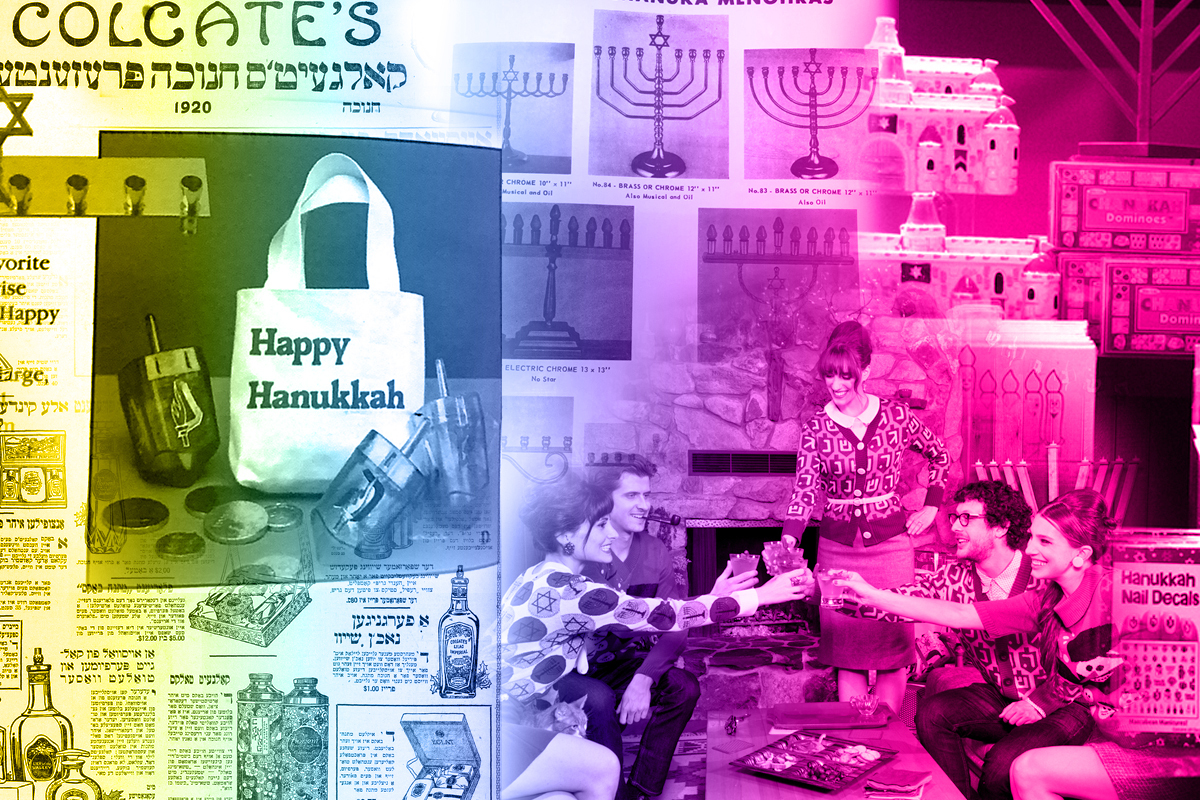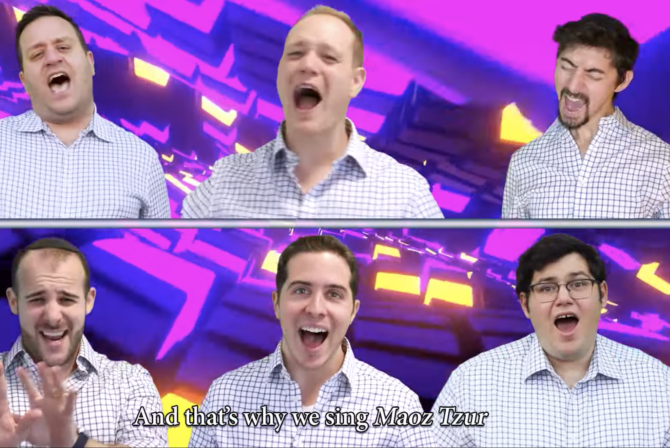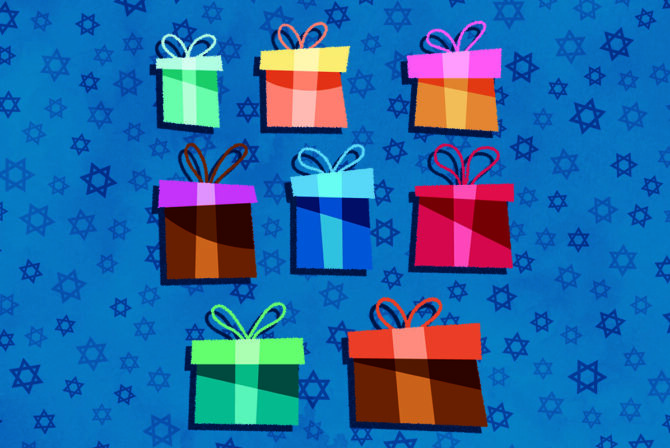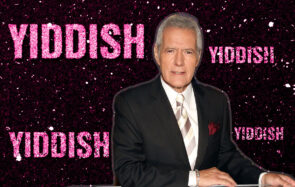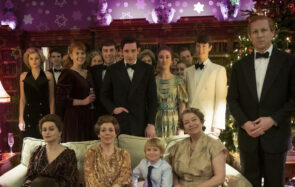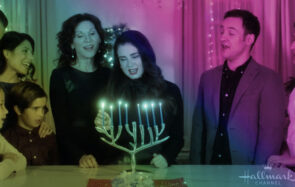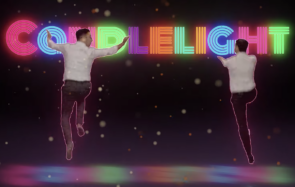在2013, I found myself transported back to the罗宋汤带- 或至少我认为是因为我的知识为主Maisel Marvelous夫人— except that, instead ofthe Catskills,我在曼哈顿的Javits中心展出了一场贸易展。在明亮的荧光灯下,我在犹太业主在制作Hanukkah礼品的犹太商业主之间进行了重聚,从电动烛台到那些在我童年的家中使用的光明节主题的烤箱手套。
It was fun to observe these individuals enthusiastically greet one another,kibbitz一起,并炫耀他们的最新商品。我当时没有意识到这一点,但我的许多同伴展会参加者代表了一个重要的美国企业家历史 - 一个历史,即我很快就成为一部分 - 这有助于将光明节作为美国的重要假期。
I arrived at the world of Hanukkah retail a bit unexpectedly in 2011. Having painted my own nails with designs appropriate for various Jewish holidays, individuals began to reach out to ask where they could buy them. I set out to discover how to produceJewish nail decals— not exactly something I learned in my rabbinical school training. Initially, I ordered the same amount for each set of nail decals, for the High Holidays, Hanukkah, and Passover (ten plagues for ten fingers, of course). Little did I know that American Jewish consumers did not treat all holidays equally. In the world of Jewish holiday merch, Hanukkah reigns supreme.
历史光明节merchin the U.S. dates back to the turn of the twentieth century, when two million Jewish immigrants from Eastern Europe came to America, the “Goldene Medine“(金色国家)。当时,美国有一个帝国的圣诞市场 - 但是没有哈杜卡朱达卡市场谈论。20世纪20年代在普通的光明节礼物中看到了成长,这是宜天报纸的广告商主要推动的东西。一种1920 Colgate adfrom theForverts,for example, demonstrates how advertisers tried to brand任何适用于Hanukkah的天赋的产品,包括儿童和香水的牙科霜。这只光明节广告有趣地包含了一棵圣诞树的形象,这是在美国节日季节的世俗象征时被考虑的。
Early Yiddish ads also encouraged readers to use American ingredients to prepare Hanukkah meals. According to food historian Jane Ziegelman, American manufacturers made a big push to introduce发酵粉和其他现代成分给犹太家庭主妇。1917年,Hecker谷物公司,例如,在这方面下了广告Yidishe Tageblatt.为“煎饼面粉”制作“Hanukkah Latkes”。Latkes通常用Schmaltz和土豆烹饪,但这广告试图让移民说服煎饼。
These new traditions of光明节gift-giving烘焙帮助光明节成为20世纪20年代和20世纪30年代的更加主流。在在美国的Hanukkah:历史,Dianne Ashton解释了20世纪40年代,拉比和犹太女性的组织鼓励母亲为汉高肯制作装饰,并拥有特殊的光明节。当圣诞节对他们的基督徒同行时,他们想让Hanukkah像对孩子一样吸引人。这是在这个时候,第一个光明节品牌产品开始出现在市场上,从光明节巧克力到Hallmark Hanukkah贺卡。
遭到破坏of the Holocaust,光明节市场经历了更多的增长。根据阿什顿的说法,“美国犹太人感觉到世界犹太人的未来取决于他们。”这位新的犹太美国精神导致了几个犹太人批发商的成立,其中许多人在曼哈顿的贸易展上由他们在曼哈顿的贸易展上出席,几十年后。
These early entrepreneurs sought to capitalize on this heightened sense of Jewish identity by bringing more Judaica into American homes. They produced the first modern Hanukkah products in bulk, beginning with traditional brass menorahs of the 1940s to musical menorahs of the 1950s to the electric menorahs of the 1960s. Alex Rosenthal, a second-generation business owner of the Judaica wholesaler Rite Lite, explained to me that when his father, Jacob, started the business, he figured that once he’d sold 1,000 traditional brass menorahs, he’d saturated the market — but the orders never stopped coming. It turns out, the marketfor menorahs比他想象的要大。
The Hanukkah marketplace continued to grow. By the 1980s, the birth of the millennial generation (of which I am a part) fueled a market for child-centered items, like Hanukkah stickers and oversized, gelt-filled dreidels. In the 1990s,Judaica wholesalers,通过贸易展示,成功赢得了Hanukkah产品在国家百货商店的架子上。Hanukkah Tablecloths,Electric Menorahs和Dreidel Cookie切割机装饰着国家链的架子,包括床浴和超越和Bloomingdale,超过三十年。这一举措全国范围内占据了光明节产品,并进一步提升了在美国的假期突出。
在线购物贡献了光明节市场的另一班。etsy和其他独立商店的新市场,包括ModernTribe, carried niche products designed by artists and small businesses that were produced on a much smaller scale. Companies likeGeltFiendhelped popularize the “ugly” Hanukkah sweaters. My own business expanded to include光明节leggings,冷肩顶部,和scrunchies.(ruth bader ginsburg,祝福记忆,写道to me that she would wear her Hanukkah scrunchie year-round!).
Retail giants such as Target also began to recognize the sales potential of Hanukkah-themed apparel. In previous years, Judaica wholesalers typically provided national chains with Hanukkah products. But since around 2015, many of these big brands have taken it upon themselves — as they already worked in clothing production — to design their very own Hanukkah apparel (including the ever-so-popular trend ofmatching Hanukkah pajamas).
Which brings us to 2020. This year, Hanukkah will certainly look different. But it’s not all bad — given the exponential growth of the Hanukkah market, people across the country now have access to Hanukkahgifts and apparelfor themselves, their children, and even their pets (oy vey!).
Over a century ago, Yiddish ads helped to situate Hanukkah as a holiday of American consumption – both literally and figuratively. Yet it was thanks to the creativity of first-generation Jewish wholesalers of the late 1940s who positioned Hanukkah to become a menorah-buying — and now, menorah-wearing — holiday in America. Those second-generation Judaica wholesalers may have had their last in-person hurrah at the Javits Center, given that in-person trade shows are likely a relic of the past. And yet, these Hanukkah entrepreneurs and their online successors have helped saturate the Hanukkah marketplace with both ritual items andhumorous apparel- 非常适合未来的稀释和毫无署的假期时刻。
